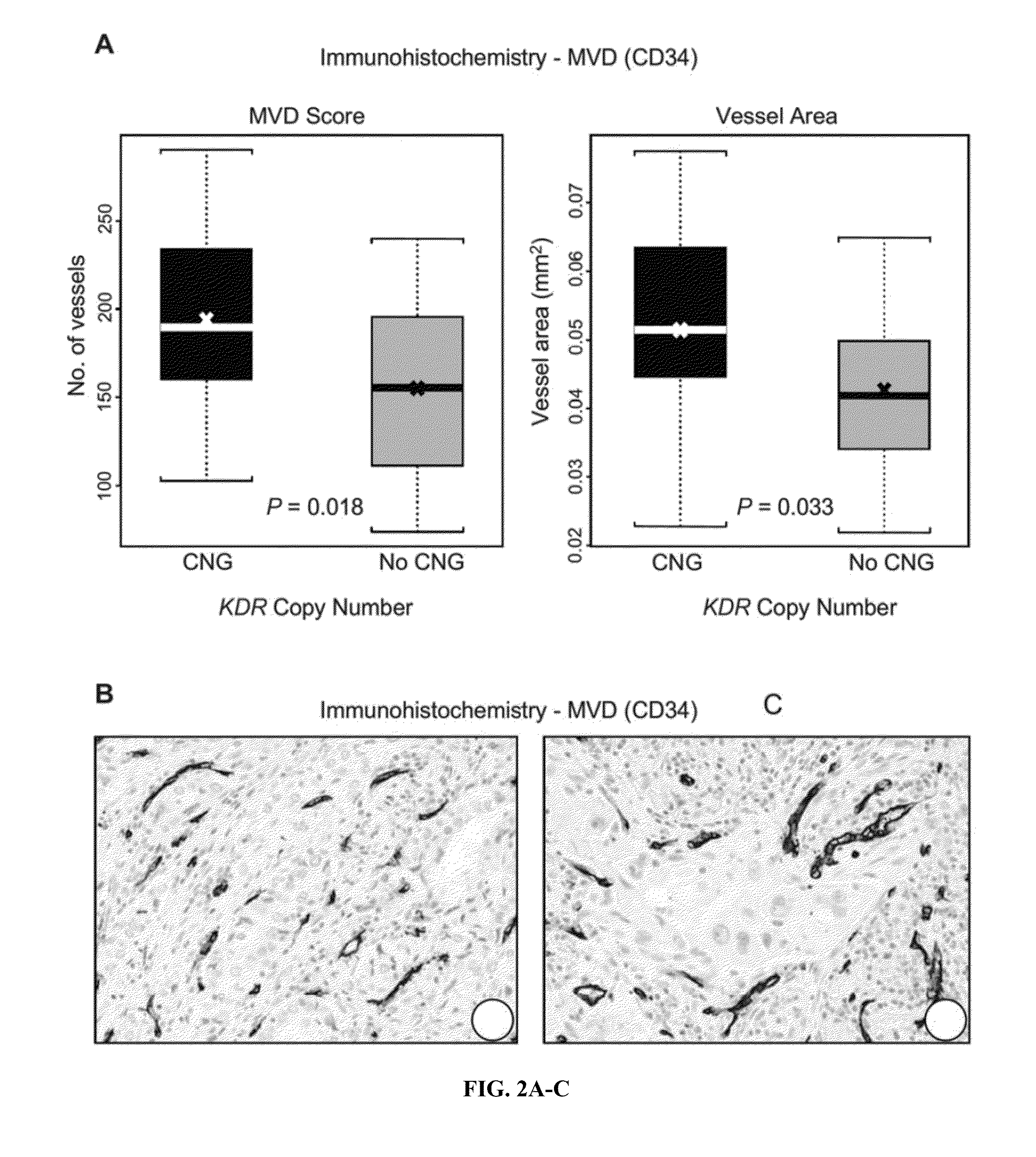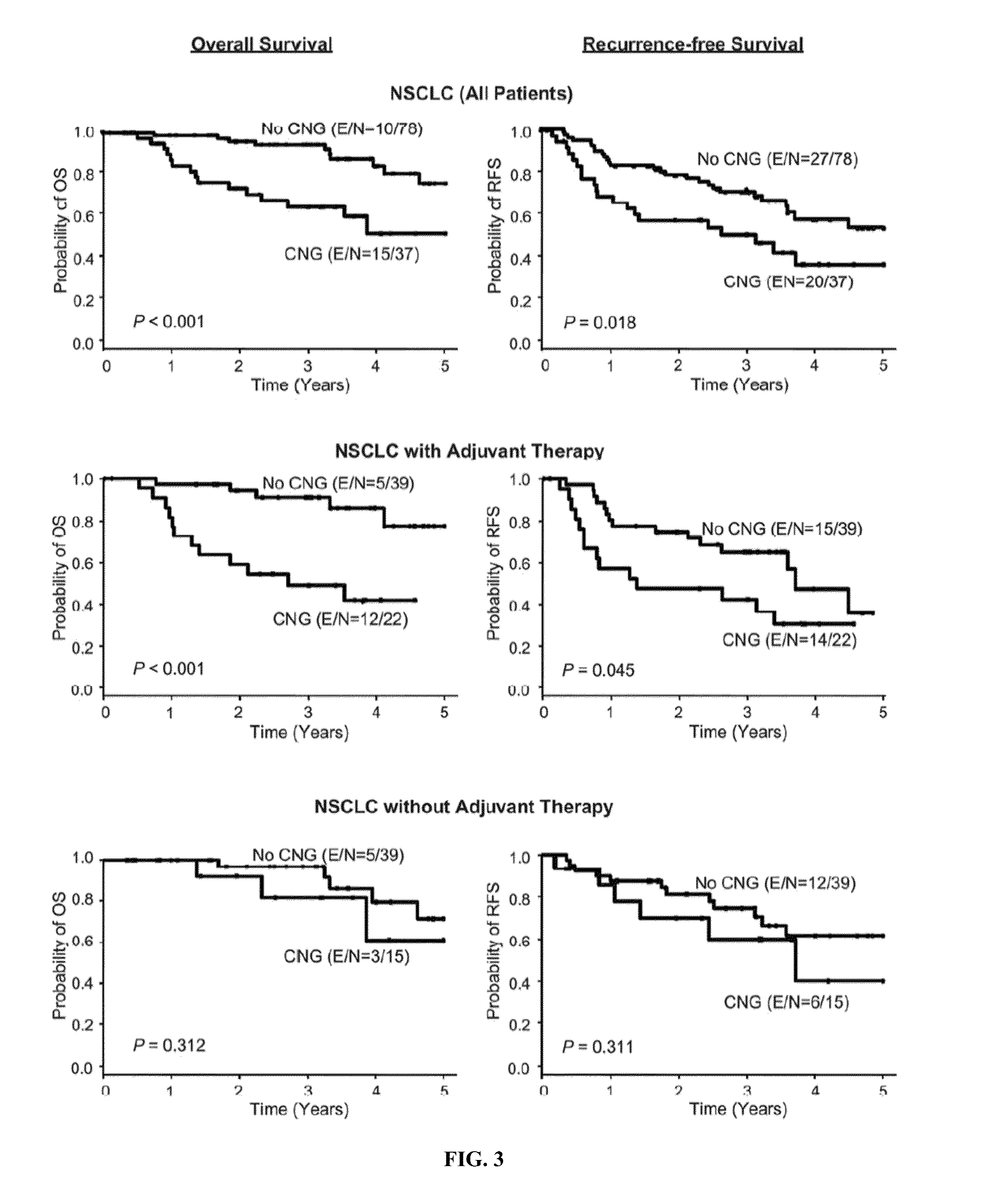Biomarkers for response to tyrosine kinase pathway inhibitors in cancer
- Summary
- Abstract
- Description
- Claims
- Application Information
AI Technical Summary
Benefits of technology
Problems solved by technology
Method used
Image
Examples
example i
[0085]The objective of this study was to characterize the molecular abnormalities of VEGFR-2 in epithelial malignant cells of NSCLC major histology types, adenocarcinoma and squamous cell carcinoma, and correlate with patients' clinical characteristics. The inventors studied KDR copy number gain (“CNG”), mutation, and genetic variations in malignant cells of surgically resected NSCLC tumor tissues and correlated the results with pathological features in NSCLC patients' tumors and with their platinum adjuvant treatments and outcomes. In addition, using a series of NSCLC cell lines and tissue specimens, the inventors investigated molecular mechanisms associated with KDR CNG in resistance to platinum, particularly the potential role of HIF-1, a key regulator of angiogenesis in malignant tumors.
[0086]Material and Methods
[0087]NSCLC Tumor Specimens and Cell Lines.
[0088]Archived frozen and formalin-fixed and paraffin-embedded (FFPE) tissues from NSCLC patients who were surgically resected...
example ii
[0131]The inventors observed that in KDR amplified cell lines, inhibition of the VEGFR pathway using the multitargeting TKI sunitinib (which has activity against VEGFR, PDGFR, and Kit) results in a decrease in cellular migration. However, imatinib, which targets BCL / ABL, Kit, and PDGFR, does not inhibit cellular migration, suggesting a role for VEGFR in migration. In contrast, the VEGFR inhibitor, sunitinib, has no effect on migration of A549 cells which do not have amplification of VEGFR. Representative data are shown in FIG. 6.
[0132]In lung cancer as well as in neuroblastoma cells, multiple receptor tyrosine kinases, including VEGFR1, EGFR, PDGFR, and RET, can drive HIF-1α levels. Therefore, whether VEGFR drives HIF-1α expression in NSCLC cells with VEGFR amplification was investigated. Higher levels of HIF-1α were observed in cell lines with VEGFR CNGs compared to those without (FIG. 7A). H23 cells (KDR CNG+) were treated with the VEGFR inhibitor sunitinib and a statistically sig...
example iii
[0133]The inventors further evaluated the effect of VEGF and VEGFR TKIs on tumor cell migration using additional NSCLC cell lines with KDR CNGs (Calu1, HCC461, and H1993). Similar to the previous observations, VEGFR TKIs decreased tumor cell migration (FIG. 10). Because the inventors found VEGFR TKIs to decrease HIF-1α levels in NSCLC cells with KDR CNGs, and HIF-1α is a key regulator of many angiogenic factors, the inventors next investigated the effect of VEGFR TKIs on tumor cell secretion of cytokines including VEGF, PDGF, IL-8, HGF, and FGF2. H23 tumor cells were treated with control media or media containing the VEGFR TKI sunitinib (1 μM) for 24 hours. Conditioned media was collected and cytokine levels were assessed by ELISA assay. VEGFR inhibition resulted in significantly decreased levels of tumor-derived PDGF-AB / BB, IL-8, and HGF (FIG. 11). Imatinib was used as a negative control as it does not inhibit VEGFR.
PUM
| Property | Measurement | Unit |
|---|---|---|
| Electrical resistance | aaaaa | aaaaa |
| Sensitivity | aaaaa | aaaaa |
| Level | aaaaa | aaaaa |
Abstract
Description
Claims
Application Information
 Login to View More
Login to View More - R&D
- Intellectual Property
- Life Sciences
- Materials
- Tech Scout
- Unparalleled Data Quality
- Higher Quality Content
- 60% Fewer Hallucinations
Browse by: Latest US Patents, China's latest patents, Technical Efficacy Thesaurus, Application Domain, Technology Topic, Popular Technical Reports.
© 2025 PatSnap. All rights reserved.Legal|Privacy policy|Modern Slavery Act Transparency Statement|Sitemap|About US| Contact US: help@patsnap.com



